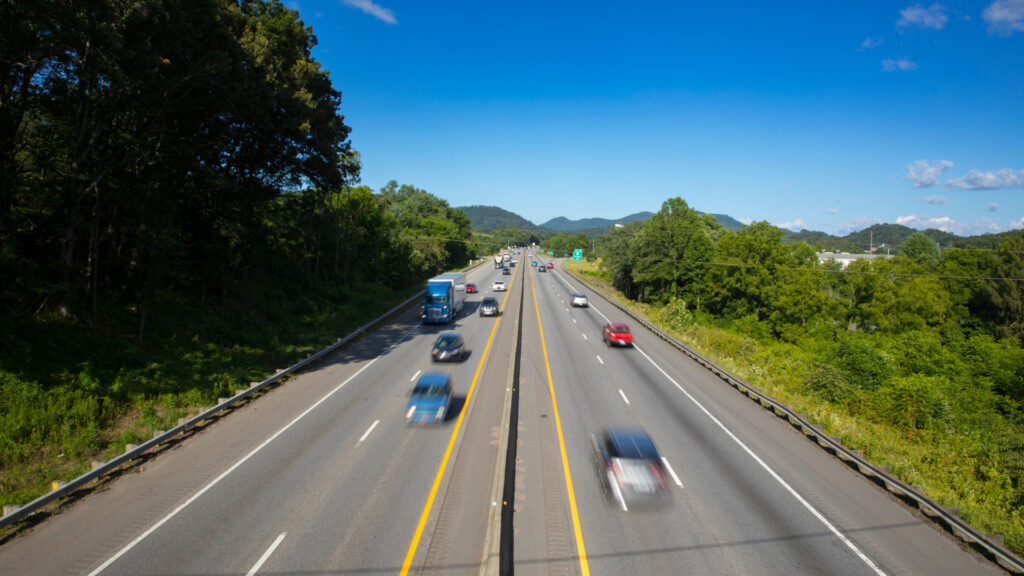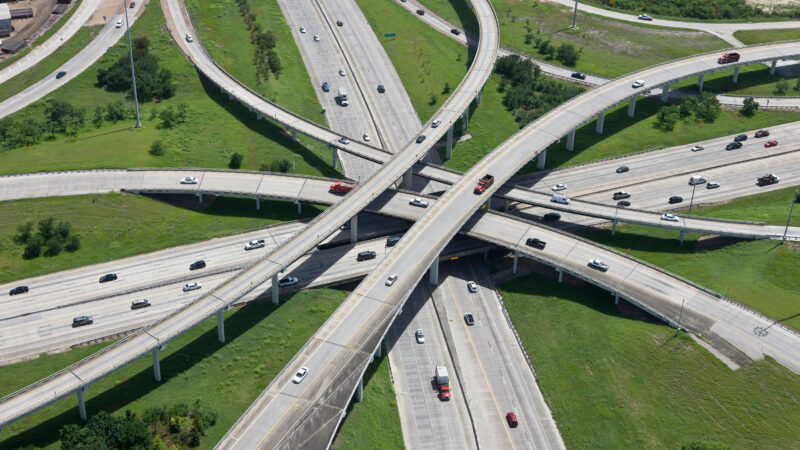Table of Contents Show
Several decades ago, the idea of traveling 70 miles per hour for hours at a time was nothing more than a dream.
However, the Interstate Highway System drastically changed the way Americans travel. Whether you’re a long-haul truck driver, a family on a road trip, or a commuter navigating rush hour traffic, it’s a game-changer.
Today, we’re exploring its history, impact on American transportation, and how it works. We’ll even give tips to help you stay safe.
So buckle up and get ready to hit the open road. Let’s get started!
What Is the Interstate Highway System?
The Interstate Highway System is a network of highways across the United States. They combine to form more than 48,000 miles of roads. They resulted from President Dwight D. Eisenhower’s Federal-Aid Highway Act of 1956.
This complex system of roads connects some of the largest cities, towns, and rural areas. It makes traveling long distances substantially easier and faster. The highways have multiple lanes in each direction, significantly impacting industries, businesses, and leisurely travel.
With the creation of the Interstate Highway System, Americans experienced more freedom and mobility. It made it possible for families to pack up their cars and head out for road trips, vacations, and many other adventures.
What Was the Purpose of the Interstate Highway System?
There was more than one purpose behind creating the Interstate Highway System. Primarily, it allowed the rapid movement of goods and military personnel during an emergency, national security threat, or natural disaster.
Secondly, the new roadway system made traveling faster and more efficient. Many of the highways and roads in urban areas experienced significant congestion and were poorly maintained. This made it challenging to get anywhere quickly in these areas.
Having multi-lane roads with limited access and increased speed limits would help resolve congestion issues.
The Interstate Highway System also aimed to grow the economy. Easily transporting goods from one location to another made it easier for new industries and businesses to start.
This resulted in job creation in construction, engineering, and many other fields.

What States Are Not Served by an Interstate?
Thankfully, all 50 states have interstate highways. However, the Interstate Highway System does not serve four state capitals. These capitals include Juneau, Alaska; Dover, Delaware; Jefferson City, Missouri; and Pierre, South Dakota.
Alaska, Hawaii, and Puerto Rico may not connect to the mainland United States. However, residents still pay federal fuel and tire taxes to contribute to the system.
Hawaii’s interstates are all on the island of Oahu. They primarily connect military and naval bases to make transporting items easy.
On the other hand, Alaska and Puerto Rico have highways part of the system that weren’t planned or constructed by the Interstate Highway System.
As a result, they typically don’t meet the standards of the other interstate roads. Do some research before embarking on a trip to these areas.
How Does the Interstate System Work?
The Interstate Highway System provides a logical and organized way to navigate the country.
However, while many drivers may think the numbers get randomly assigned, that’s not the case. There’s much more thought and organization behind their given route number.
Each route receives an identification number. All highways running north to south receive odd numbers, and those running east to west receive even numbers. The system starts in the west and south and increases as you move east and north across the country.
A highway with a three-digit number identifies a spur, loop, or other auxiliary route connecting to the highway. Spurs are three-digit numbers that start with an even number, and loops are three-digit numbers that begin with an odd number.
What Is the Difference Between a Freeway and an Interstate?
Many drivers use the terms “freeway” and “interstate” interchangeably. However, while they may be similar, there is a difference between the two.
Freeways are a type of road designed to provide traffic with high speeds and uninterrupted flows. They’re typically multiple lanes in each direction and include access ramps. Traffic typically enters and exits the freeway through interchanges.
On the other hand, interstates are highways that span the entire United States. They make travel easier and connect cities and regions across the country. The federal government maintains its uniform design standards with state funding.
So, while all interstates are freeways, not all freeways are interstates. Many freeways throughout the country are not part of the Interstate Highway System.
These may include state highways or local roads designed as freeways to provide efficient and safe travel for local or regional traffic.
Read More: Dive further into the differences between interstates, freeways and highways!
Tips for Driving on the Interstate Highway System
Driving on the Interstate Highway System can be an efficient and convenient way to travel long distances. However, it can also be challenging, especially for new and inexperienced drivers.
Luckily, you can several things to stay safe and avoid the dangers of the Interstate Highway System.
Follow Traffic Laws
You should always follow the traffic laws when driving on an interstate highway. Unfortunately, traffic laws can vary from state to state.
Be aware of any unique laws when traveling in an unfamiliar state. You are responsible for obeying the laws of the land when passing through. Unfortunately, ignorance isn’t bliss, and law enforcement can issue citations.
For example, speed limits vary considerably from state to state. In Hawaii, speed limits are typically 55 to 60 miles per hour. However, in the Lone State State of Texas, drivers can legally drive 75 to 85 miles per hour.
Stay Alert
While the Interstate Highway System can allow you to cover a considerable distance quickly, it can be tedious.
Depending on traffic, you can drive for hours without changing lanes. If you’re not careful, you can easily doze off or lose focus on driving.
Stay alert to the task at hand. Take breaks to stretch your legs, use the restroom, or get a coffee when necessary. This is one of the reasons why you’ll frequently see rest stops along interstate roads.
Getting out of the vehicle for a few minutes is enough to help you maintain your energy and focus.
Keep in Mind: If you’ve been driving for hours, it will get difficult to maintain focus. Some believe highway hypnosis is to blame, but is it a real thing?

Maintain Your Distance
Your vehicle’s stopping distance will significantly increase the faster you go. When traveling 70 miles per hour, stopping a standard vehicle takes approximately 350 feet.
As a result, you’ll want to ensure you keep plenty of distance between you and the vehicle in front of you. If they stop, you’ll need time to react and then for your car to come to a complete stop.
This is one of the primary reasons why driver’s education courses emphasize the three-second rule. This is the suggested distance between vehicles during typical driving conditions.
However, you’ll want to increase the distance in bad road conditions. Rain, snow, and fog are all instances where you’ll want to add space between your vehicle and others on the road.
Use Your Signals
When driving on the interstate, use your signals. Turn signals and other indicator lights make it easy for drivers to communicate with one another. Doing so can allow drivers to adjust to accommodate changing lanes and other traffic maneuvers.
Despite using signals taking minimal effort, many drivers fail to use them. Failure to do so can lead to confusion and dangerous situations during heavy traffic.
Do yourself and other drivers a favor, and always use your signals, even if just changing lanes. You must let others know your intent to avoid accidents.

Stay to the Right
One mistake many drivers make on the Interstate Highway System is riding in the left lane.
The left lane is for passing. You should not drive in it if you are not actively passing another vehicle. Keeping this lane clear helps ensure traffic flows smoothly and efficiently.
Many states have laws regarding drivers riding in this lane. Law enforcement can issue citations for these violations. While it may not be a significant offense, it can impact your wallet. Slower traffic in the left lane can impede the flow and cause unnecessary congestion.
Plan Ahead
Traveling on interstates will require planning. You’ll need to plan your stops ahead of time to avoid running out of fuel.
Depending on where you travel, you could have a considerable distance between fuel stations. In some spots out west, it’s common to see 50, 75, or even 100 miles between fuel stations.
In addition to fuel, you’ll want to plan meals and bathrooms accordingly. Just about everyone has been on a road trip where someone has had to use the restroom. It can be a miserable experience for everyone in the vehicle.
Navigating the Interstate Highway System can be challenging, but it doesn’t have to be. Proper preparation and following our tips can allow you to travel easily and confidently.
From planning your route to staying alert behind the wheel, you can adopt several strategies to make your journey safe, efficient, and enjoyable.
So what are you waiting for? Get out there and use this highway system to explore breathtaking landscapes while making unforgettable memories. You won’t regret it!






